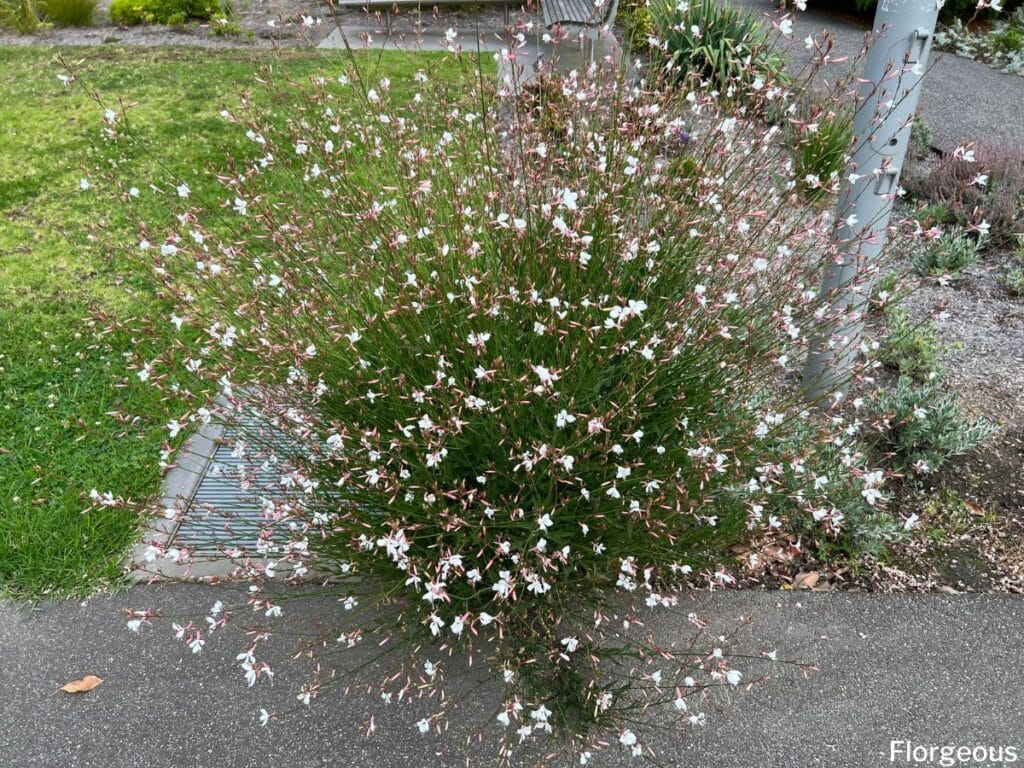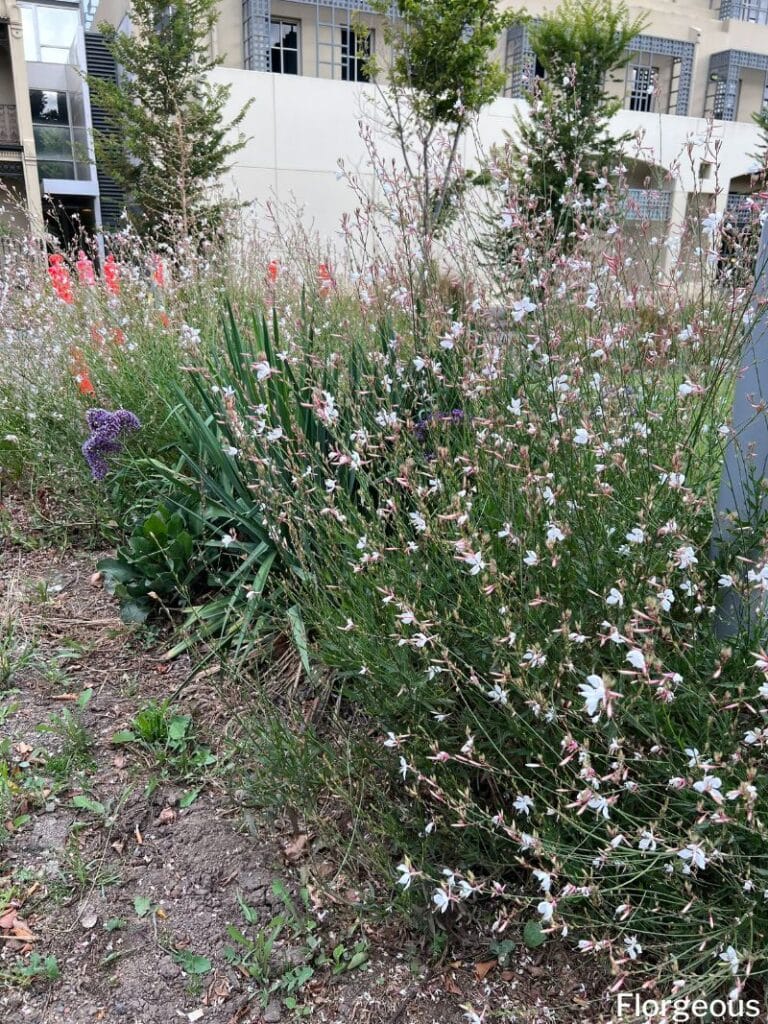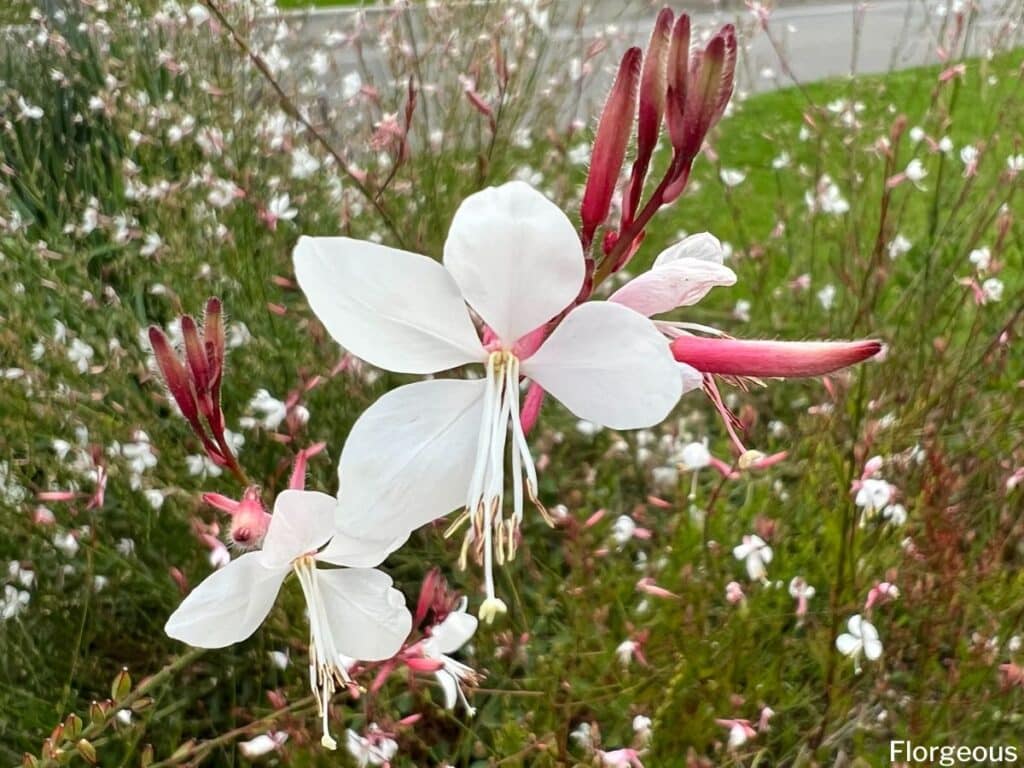Gaura plants, also known as Beeblossom, wandflowers or whirling butterflies, are beautiful perennials with thin, delicate stems and white or pink flowers that grow in clusters. They are easy to grow, but they must be cared for properly in order to thrive.
Here’s your ultimate guide to gaura plant care so you can enjoy these lovely white or dark pink flowers all season long!
Gaura Flower Facts
| Scientific name | Oenothera lindheimeri |
| Common names | Whirling butterfly, wandflower, bee blossom, gaura |
| Family | Onagraceae |
| Plant Type | Herbaceous perennial |
| Height and Width | 15-48 inches wide, 15 to 48 inches tall |
| Origin | North America |
| Flower colors | White, pink |
| Foliage color | Pale green (sometimes variegated) |
| Sun Exposure | Full sun |
| Soil Type & pH | Acidic, neutral, alkaline soils all tolerated, sandy soil preferred |
| Special features | Low-maintenance, good for dry weather, good accent plants |
How to Grow Gaura

Gaura flowers come in all shapes in sizes, blooming from late spring to early summer. With long thin stems and four petals of delicate white flowers or pink buds, gaura flowers are perfect for any garden.
Larger gaura plants add an interesting texture and color contrast when planted with other perennials in a mixed perennial border, such as coneflowers, coreopsis, black-eyed Susan, daisies, salvia, lavender, or even ornamental grasses.
Planting gaura with other perennials creates an eye-catching mixed border that provides visual interest throughout the growing season. They can also add a touch of color and are known to attract butterflies in places like rock gardens.
It also has a long flowering season and is somewhat drought tolerant, making growing gaura a good choice for a less than desirable planting site.
When you plant gaura, it’s important to note that it can spread aggressively if given the right conditions, so be sure to use caution when selecting where you will place your plants.
Propagation
Gaura can be propagated from stem cuttings taken from healthy plants during the spring or summer months. Start by cutting 4–6 inch sections of the stem just below a leaf node, then dip the cut end into rooting hormone before planting into a moist potting mix.
Soil
Gaura plants prefer soil that is loose and well-draining. The ideal pH level is around 6.5, though they can tolerate slightly acidic or alkaline soils as well.
When planting your flowering plants, make sure that your soil has ample amounts of organic matter such as compost or manure—this will help ensure healthy growth and flowering throughout the season.
Pruning
If necessary for size control or aesthetic purposes, lightly prune back mature stems by about one-third of their original height for reblooming through the late summer and early fall months. This can also encourage more blooms.
Repotting and Transplanting
If your gaura plants become too large for their current location, then you may choose to repot them into larger containers or transplant them into beds for more room for growth.
To repot your plant, simply remove it from its current container and plant in a larger one filled with fresh potting mix amended with compost if necessary for additional nutrition needs of your plant.

How to Care for Gaura Plants
Caring for a gaura plant doesn’t have to be complicated! With just a few simple steps—watering regularly, using the right soil type, and adding plenty of organic matter—you can enjoy beautiful blooms all summer long.
Water
Gaura plants need regular watering for their bright pink flowers to thrive, but are drought tolerant. Water your gaura plant every other day or so, making sure that the soil stays moist but not soaking wet. In especially hot climates, you may need to water more often.
Sunlight
The best location for your gaura plant will depend on the climate you live in and the type of plant you have.
If you live in USDA Plant Hardiness Zones 4-8, it’s best to place your gaura plants in an area where they will get at least 4 hours of direct sunlight per day. This can be a south-facing window or patio that receives full sun all day long.
When selecting gaura companion plants, you need to take into account these growing conditions.
Temperature and Humidity
When it comes to temperature, gauras prefer temperatures between 65-75°F. In warmer climates they can tolerate temperatures up to 80°F, but should not be exposed to temperatures any lower than 50°F.
The ideal humidity level for gaura plants is around 50%. However, they can tolerate higher levels of humidity as long as there is enough airflow around the leaves to keep them from becoming too wet or humid.
Fertilizer
Gaura plants should be fertilized in spring, when new growth begins, as well as in mid-summer. Always make sure that the soil is moist before you apply fertilizer; dry soil can cause fertilizer burn on the plant’s roots.
Pest and diseases
Gaura plants can be susceptible to various types of insects. Aphids, spider mites, mealybugs, whiteflies, thrips, leafhoppers, and sawflies are all common pests that can feed on the leaves or flowers of gaura plants.
The best way to rid your plant of pests is through physical removal or by using an insecticidal soap or neem oil spray.
Aside from pest infestations, gaura plants may also suffer from fungal diseases such as powdery mildew or root rot. Powdery mildew is a white-grayish fungus that appears on the surface of leaves and flower stems as grayish-white spots.
To prevent this disease from occurring, make sure your gaura plants have adequate air circulation and spacing between other plants in order to reduce humidity levels around the plant.
Root rot is caused by overwatering leading to waterlogged soil conditions which in turn leads to fungi growth on the roots resulting in rotting of the root system.

Common Gaura Varieties
To help you decide which gaura variety is right for your outdoor space, here are some of the most popular cultivars, including everybody’s favorite, Whirling Butterflies.
- Siskiyou Pink Gaura (Gaura lindheimeri ‘Siskiyou Pink’)
- Whirling Butterflies Gaura (Gaura lindheimeri ‘Whirling Butterflies’)
- White Swan Gaura (Gaura lindheimeri ‘White Swan’)
- ‘Geyser Pink Gaura’
- ‘Passionate Rainbow’
- ‘Crimson Butterflies’
FAQs
When should you cut back gaura?
Gaura plants benefit from cutting back in late winter or early spring before new growth emerges. This helps promote bushier growth and encourages more prolific flowering during the growing season.
Does gaura need deadheading?
Deadheading, or removing spent flowers, can prolong the blooming period of gaura plants. It encourages the plant to redirect its energy into producing new flowers rather than setting seeds.
Can gaura be overwatered?
Gaura plants can be overwatered, especially if planted in soil that doesn’t drain well. Overwatering can lead to root rot and other fungal diseases. It’s important to allow the soil to dry out slightly between waterings and ensure proper drainage to prevent waterlogging.
Conclusion
Gauras are easy to take care of if you follow these simple guidelines. With just a few steps, you’ll be able to enjoy these lovely plants for many years! Don’t forget to check our list of flowers for more amazing plants to grow.







